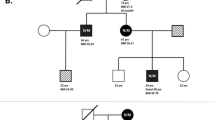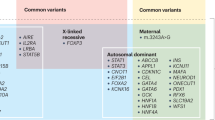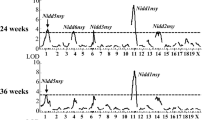A gene for maturity onset diabetes of the young (MODY) maps to chromosome 12q (original) (raw)
- Article
- Published: 01 April 1995
- Valérie Boccio1 nAff6,
- Anne Philippi1 nAff6,
- Corinne Vigouroux1 nAff6,
- Joe Terwilliger3,
- Philippe Passa4,
- Jacques S. Beckmann5,
- Gilberto Velho6,
- G. Mark Lathrop3,6 &
- …
- Philippe Froguel1,4 nAff6
Nature Genetics volume 9, pages 418–423 (1995)Cite this article
- 425 Accesses
- 186 Citations
- 9 Altmetric
- Metrics details
Abstract
Maturity–onset diabetes of the young (MODY) is a subtype of non–insulin dependent diabetes mellitus, with early age of onset. MODY is genetically heterogeneous, associated with glucokinase mutations and a locus on chromosome 20q; in about 50% of cases, its genetic background is unknown. We have studied 12 families in which MODY is unlinked to either glucokinase or chromosome 20q markers, and find significant evidence for linkage with microsatellite markers on chromosome 12q, most likely within a 7 centimorgan interval bracketed by D12S86 and D12S342. The disease was estimated to be linked to this chromosome region in approximately 50% of families in a heterogeneity analysis. These MODY patients exhibit major hyperglycaemia with a severe insulin secretory defect, suggesting that the causal gene is implicated in pancreatic β–cell function.
This is a preview of subscription content, access via your institution
Access options
Subscribe to this journal
Receive 12 print issues and online access
$209.00 per year
only $17.42 per issue
Buy this article
- Purchase on SpringerLink
- Instant access to full article PDF
Prices may be subject to local taxes which are calculated during checkout
Additional access options:
Similar content being viewed by others


Monogenic diabetes
Article 09 March 2023

References
- Fajans, S.S. Scope and heterogeneous nature of MODY. Diabetes Care. 13, 49–64 (1990).
Article CAS Google Scholar - Froguel, P., Velho, G., Cohen, D. & Passa, P. Strategies for the collection of sibling-pair data for genetic studies in type 2 (non insulin-dependent) diabetes mellitus. Diabetologia. 34, 685 (1991).
Article CAS Google Scholar - Bell, G.I. et al. Gene for non-Insulin dependent diabetes mellitus (maturity-onset diabetes of the young subtype) is linked to DNA polymorphism on human chromosome 20q. Proc. natn. Acad. Sci. U.S.A. 88, 1484–1488 (1991).
Article CAS Google Scholar - Froguel, P. et al. The glucokinase locus on chromosome 7p is closely linked to early onset non insulin dependent diabetes mellitus. Nature. 356, 162–164 (1992).
Article CAS Google Scholar - Gidh-Jain, M. et al. Glucokinase mutations associated with non-insulin-dependent (Type 2) diabetes mellitus have decreased enzymatic activity: implications for structure/function relationships. Proc. natn. Acad. Sci. U.S.A. 90, 1932–1936 (1993).
Article CAS Google Scholar - Froguel, P. et al. Familial hyperglycemia due to mutations in glucokinase: Definition of a subtype of diabetes mellitus. New Engl. J. Med. 328, 697–702 (1993).
Article CAS Google Scholar - Vaxillaire, M. et al. Search for a third susceptibility gene for maturity-onset diabetes of the young. Studies with eleven candidate genes. Diabetes. 43, 389–395 (1994).
Article CAS Google Scholar - Weissenbach, J. et al. A second-generation linkage map of the human genome. Nature. 356, 794–801 (1992).
Article Google Scholar - Vignal, A. et al. A non-radioactive multiplex procedure for genotyplng of microsatellite markers. In Methods In Molecular Genetics: Gene and Chromosome Analysis (ed. Adolph, K.W.) 211–221 (Academic Press, San Diego, 1993).
Google Scholar - Herman, W. et al. Abnormal insulin secretion, not insulin resistance, is the genetic or primary defect of MODY in the RW pedigree. Diabetes. 43, 40–46 (1994).
Article CAS Google Scholar - Velho, G. et al. Primary pancreatic b-cell secretory defect caused by mutations in the glucokinase in kindreds of maturity onset diabetes of the young. Lancet 340, 444–448 (1992).
Article CAS Google Scholar - NIH/CEPH Collaborative group. A comprehensive genetic linkage map of the human genome. Science. 258, 67–86 (1992).
- Lathrop, G.M. & Lalouel, J.M. Easy calculations of lod scores and genetic risks on small computers. Am. J. hum. Genet. 38, 460–465 (1984).
Google Scholar - Ott, J. Human Genetic Diseases :A Practical Approach (ed. Davies, K.E.) 19–32 (IRLPcrs, Oxford, 1991).
Google Scholar - Snedecor, G.W., Cochra, W.G., In Statistical methods (Iowa State University Press, Ames, Iowa, 1989).
Google Scholar - Kramer, C.Y. Extension of multiple range tests to group means with unequal numbers of replications. Biometrics 12, 309–310 (1956).
Article Google Scholar
Author information
Author notes
- Martine Vaxillaire, Valérie Boccio, Anne Philippi, Corinne Vigouroux & Philippe Froguel
Present address: CEPH, 27 rue Juliette Dodu
Authors and Affiliations
- CNRS EP10, Institut Pasteur de Lille, 75010, Paris, France
Martine Vaxillaire, Valérie Boccio, Anne Philippi, Corinne Vigouroux & Philippe Froguel - The Wellcome Trust Centre for Human Genetics, Windmill Road, Oxford, OX3 7BN, UK
Joe Terwilliger & G. Mark Lathrop - Service d'Endocrinologie, Hôpital Saint-Louis, 1 avenue Claude Vellefaux, Paris, 75010, France
Philippe Passa & Philippe Froguel - Généthon, 1 rue de l'Internationale, BP60, 91002, Evry, France
Jacques S. Beckmann - INSERM U358, 12 rue de la Grange aux Belles, 75010, Paris, France
Gilberto Velho & G. Mark Lathrop
Authors
- Martine Vaxillaire
You can also search for this author inPubMed Google Scholar - Valérie Boccio
You can also search for this author inPubMed Google Scholar - Anne Philippi
You can also search for this author inPubMed Google Scholar - Corinne Vigouroux
You can also search for this author inPubMed Google Scholar - Joe Terwilliger
You can also search for this author inPubMed Google Scholar - Philippe Passa
You can also search for this author inPubMed Google Scholar - Jacques S. Beckmann
You can also search for this author inPubMed Google Scholar - Gilberto Velho
You can also search for this author inPubMed Google Scholar - G. Mark Lathrop
You can also search for this author inPubMed Google Scholar - Philippe Froguel
You can also search for this author inPubMed Google Scholar
Rights and permissions
About this article
Cite this article
Vaxillaire, M., Boccio, V., Philippi, A. et al. A gene for maturity onset diabetes of the young (MODY) maps to chromosome 12q.Nat Genet 9, 418–423 (1995). https://doi.org/10.1038/ng0495-418
- Received: 19 December 1994
- Accepted: 03 February 1995
- Issue Date: 01 April 1995
- DOI: https://doi.org/10.1038/ng0495-418